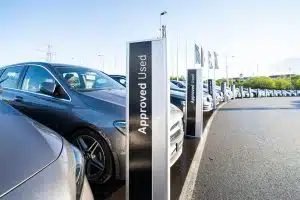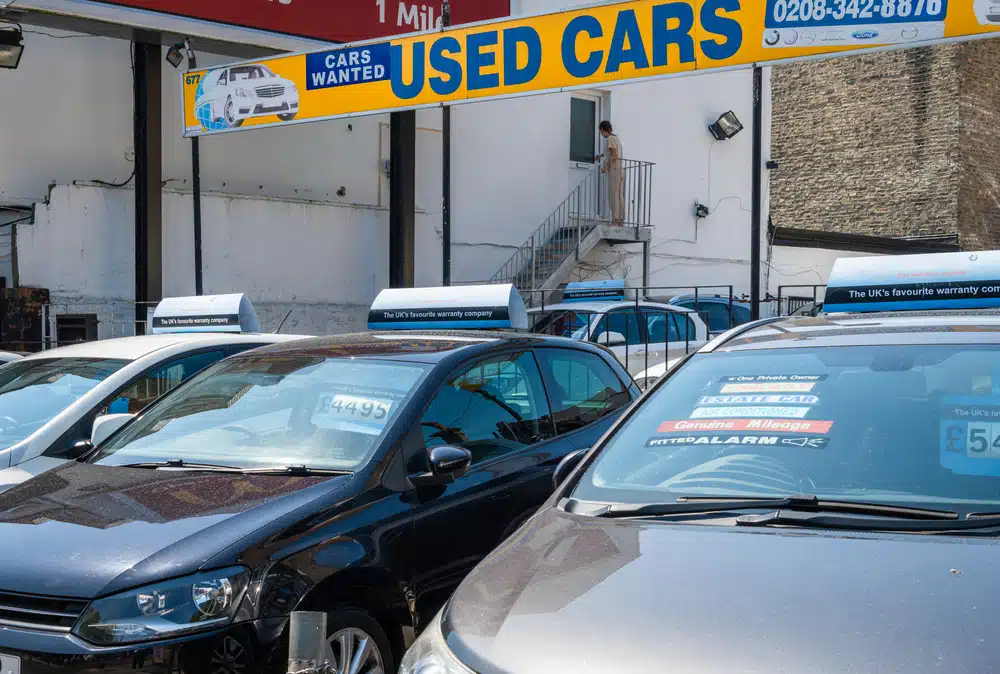 In the United Kingdom, there are many used car dealerships. These businesses typically buy used cars from individuals and then resell them. Some used car dealerships also offer financing, which can make it easier for customers to purchase a car. Many people in the UK choose to buy a used car because it is often more affordable than a new car.
In the United Kingdom, there are many used car dealerships. These businesses typically buy used cars from individuals and then resell them. Some used car dealerships also offer financing, which can make it easier for customers to purchase a car. Many people in the UK choose to buy a used car because it is often more affordable than a new car.
Used car dealerships can be found in most towns and cities, and they usually have a wide selection of cars to choose from. If you are considering buying a used car, it is important to do your research so that you can find a reputable dealer. You should also take the time to test drive the car and inspect it carefully before making a purchase.
When selling used cars, it is essential to establish a reputation for quality. This guide will cover all that you need to know when it comes to starting up and running a used car dealership in the United Kingdom.
Research your target market
Choosing a business model that will attract a lot of customers will be essential. Including both popular vehicle types and affordable prices in your inventory will allow you to serve your local customers better. Take into consideration the affluence of the area. It is often possible to tell by looking at local housing. Consider the types of cars people have in their driveways and on the road. Local classified ads and other dealers’ listings advertise what types of cars?
The market may be broader, of course. A regional or even national newspaper might be a good place to advertise cars, for example. You can also reach a large number of potential customers by advertising cars online, including on eBay.
You should conduct ongoing market research. Start by talking to your customers to learn more about their needs and wants after you start trading. Make note of the colours, models, and makes that are popular, and those that aren’t. Get to know which features are popular with customers (such as parking sensors).
Finding out about your competitors
What is the level of service your existing business provides to your potential customers? You should also take note of franchised motor dealers in your area. Keep an eye out for home-based small-time dealers or ‘dabblers’. You can learn more about how many dealers are already operating in the area by browsing Yell.com, free local newspapers and locally published ‘cars for sale’ sections. Don’t forget to search online as well.
It is often possible to tell a lot about your competitors’ businesses from their advertisements. There are many online sellers selling used cars, including eBay traders, including private sellers and dealers.
It is your most important competitors who offer similar vehicles and services to yours. You should learn as much about them as possible, including:
- There is a wide selection of vehicles available
- Prices (are they close to or significantly below/above the ‘book’ price) and the age of their stock.
- Their range of services (such as indoor showrooms, insurance-backed warranties, finance, etc.)
Investigate your competitors’ reputations if possible. What is their customer service like? You might be able to get an idea of how their sales staff approach their customers if you visit their premises.
You might actually be competing with local dealers who are actually your customers rather than just your competitors. It is possible for you to regularly receive low value vehicles as part exchanges and sell them to another dealer. Co-operating with several local dealers may be beneficial for you.
Decide what services to offer
Depending on your business, you may already offer some services, such as repairs or fuel sales. It may also be possible for your new business to offer a number of different services along with used car sales. Aside from car sales, you may be able to generate income from other business activities depending on the facilities you have:
- Vehicle servicing and repairs
- Car valeting
- MOT testing
- Bodywork and accident repairs
- Other vehicle services, for example alarm fitting or LPG gas conversions
- Motor part and accessory sales
- Petrol retailing and perhaps convenience retailing
- General forecourt services, for example car cleaning facilities
- Car hire
As part of your used car sales operation, your customers may expect certain ‘added value’ services and facilities. Among them are:
- Customers with poor credit histories may be able to obtain financing
- Insurance packages and extended warranty schemes are available
- A vehicle inspection facility (such as a floodlit area, a canopy, or an indoor showroom)
- Vehicle part exchanges
- A reputable motoring organisation conducts a pre-inspection of vehicles
- Inspected for theft, serious accident damage, ‘clocked’, or outstanding hire purchase payments (HPI check), to ensure they are not stolen.
You can earn commissions on some of the above sales, including finance and extended warranties.
Your quality policy will dictate whether you sell cars as they are or if you put a lot of effort and money into bringing them up to retail standards. You might offer every car sold to a retail customer a new MOT and a full service. If you offer a no-quibble exchange policy or a free extended warranty, perhaps your customers will be able to take advantage of it.
If your business offers other services, consider adding them. For customers who need a particular vehicle, you might provide a car locator service. For customers who want to purchase a new car from the continent, you can set up a parallel import operation. In addition to your used selection, you may decide to stock some new cars imported parallel.
Your advertising materials should mention any attractive services and facilities you offer.
Selling cars on finance
Vehicles are big, expensive purchases. The balancing payment may need to be spread over several months or years for others who are unwilling or unable to pay all at once.
It has become increasingly popular for consumers to purchase personal contracts (PCP). Customers who choose this type of arrangement pay a down payment and then make fixed monthly payments that pay off just the vehicle’s depreciation. For an agreed final payment, the customer can purchase the car at the end of the contract period. A concern that household budgets were becoming overstretched led the Financial Conduct Authority (FCA) to investigate PCPs in 2017.
You may want to work with a specialist finance company to offer credit to your customers. Many motor trade finance companies offer a range of different credit packages, and they specialise in offering motor trade finance. To attract customers, you may offer the following finance packages:
- Standard interest bearing credit
- Subsidised interest rate credit
- Interest free credit
- Deferred payment (buy now pay later) credit
- High risk credit
As part of the sales process, you will need to fill out a credit application with the customer in order to introduce them to a finance provider. A decision will then be made by your finance company regarding the application. The finance company will pay you for the vehicle within a few days if everything goes smoothly. In addition to your salary, you will usually receive a commission. At the end of the month, you are paid a percentage of the sale value.
It is common for finance companies to require you to meet certain standards and requirements before they will do business with you. A certain minimum length of time, usually two years, is required by some lenders before they will deal with a business.
Choose a finance company carefully when it comes to your finances. Terms and working practices vary between them. Taking into account the following considerations will help you choose the best one for your company:
- What type of finance package you offer
- When will you receive payment from the finance company
- What is your commission rate?
- What is the turnaround time for your customers’ credit applications
- How much support and backup do you offer
Finance is only available to your customers if you have consumer credit authorisation. Depending on your credit activities, you may only need limited authorisation authority, but you may also need permission to handle debt counselling involving part-exchange vehicles (taking over unpaid finance and advising customers). The FCA grants authorisation. On the FCA website, you can find more information about consumer credit.
Pricing policy
Choosing your target price bracket is one of the first steps in your planning. Your customers should be able to afford what you offer. To cater to different types of consumers, you might stock cars in different price brackets.
Pricing individual vehicles
Consider the following factors when pricing individual vehicles:
- What was the price of the vehicle?
- Did you acquire the vehicle through a part exchange, or did you buy it outright?
- How long have you had the vehicle in stock?
- Would you be willing to haggle on price?
- Taking into account the vehicle’s age, condition, mileage, etc., what is the ‘book’ price?
- What is the expected price of that type of car among local customers
‘Book’ prices are published in trade price guides by specialist research firms. Most car dealers refer to them regularly because they are regularly updated. Forecourt and part exchange prices are available in a variety of price guides. Prices for cars can also be found online. There is also a good deal of information available to motorists about current prices. There is usually a difference in prices between forecourt and private sale vehicles, because dealerships usually offer a warranty and have a larger selection of stock than private sellers.
Pricing part exchange vehicles
When it comes to pricing, it’s important to decide how much to offer customers who want to part exchange their old vehicles. Despite the fact that trade price guides are useful, it is also important to consider the following:
- Based on the part exchange allowance and the retail price of the new car, what will be the overall ‘price to change’ for the customer
- What is the value of the part exchange vehicle?
- Can the part exchange vehicle be sold without much work?
- Is it likely that the vehicle will sell quickly and easily?
- Do you plan to sell the vehicle on your own forecourt, or will you sell it to another trader or through an auction?
The part exchange price may be negotiated by some potential customers, but others may walk away if the offer is too low.
You should only enter £3,000 as ‘Cash sales’ in the cash flow if, for example, you sell a car for £5,000 with a part exchange allowance of £2,000 (prices are included for illustrative purposes only). When you sell the part exchange vehicle, you will receive the balance; if you sell it to a trader, this might become ‘Cash from debtors’. The total selling price of £5,000 must be entered immediately in your stock book for VAT purposes.
Pricing at auctions
An auction is a place where you can bid on vehicles for your stock against other traders. A starting price will be set by the auctioneer, and he will aim to get the highest price possible for each vehicle. Some vehicles will be auctioned without a reserve (minimum price), while others will have a reserve (minimum price).
A maximum price for a vehicle is something you will have to decide. Your profit margin should be high enough to allow you to sell it on for a reasonable price. Additionally, it should reflect the possibility of having to spend money repairing any faults that may arise after you purchase the vehicle.
Auctions may also be used to dispose of stock from time to time, such as old part exchanges and cars that aren’t selling on the forecourt. If a reserve is necessary, you can decide how much to set. The same is true for online auctions such as eBay.
Your pricing policy
Decide how you will price your products and try to follow it as closely as possible. Your business’s financial side will then be able to be planned.
Set a goal for yourself. Perhaps you will always aim to add 20% to the car’s cost price when you sell it when you sell it. Alternatively, you may aim to make a certain amount per car. The book price may be kept, or you may try to undercut it. You may be able to offer cars at a higher price because of the quality of your service or even the location of your sales site. Also decide what your policy is regarding trade-ins to other dealers.
There might be a small amount or percentage you will add, or maybe you will accept cost-plus. Occasionally, you may be able to sell vehicles as part of a job lot for a total price that has been agreed upon.
Different types of vehicles may require different profit margins. If you have an older ‘banger’, you may add a higher percentage than you would if you had a nearly new, high-value vehicle. Remember that sometimes you will need to make up for a low profit margin on one vehicle by making more profit on another.
Pricing other services
You will need to figure out how much you will charge if your business offers other services like repairs or valeting. To make that service worthwhile, you should consider the cost of providing it to your business, as well as the profit you need to make.
Buy an existing business
The alternative to starting your own used car dealership is to buy an existing one. An existing business may include cars, customers, regular sales, staff, premises, and equipment.
A company’s reputation can make or break a company’s reputation in the motor industry. A business with a bad reputation may take a lot of time and effort to turn around.
Before agreeing to a price, you should check the age, condition, and value of any stock you intend to purchase. It is important to keep the stock valuation up to date because used car values can drop rapidly. If you take over a diesel vehicle, be aware that demand for diesel models has weakened.
You’ll need legal and financial expertise on your team if you want to buy a business successfully. Make sure the business has a solid financial and trading position before paying a high price for it.
How to Start Your Own Car Dealership
Conclusion
In order to start a used car dealership, car traders need to be aware of legislation that is involved with the sale of vehicles in the UK. You need to ensure you have the right to sell the vehicle as well as the vehicle needs to match the description given by the buyer. The consumer rights Act of 2015 comes into play when selling new and used cars from official dealers, this also included servicing, repairs and maintenance work.
This is imports to used car dealerships as customers have 30 days to reject the vehicle if a fault renders the product not of satisfactory quality, not fit for purpose or not as described. Start up car dealers also need to comply with the Consumer Protection from Unfair Trading Regulations (2008), which prohibit them from engaging in unfair business practices
Jarred Musson is a versatile writer with a diverse educational background and a passion for all things business. Holding a Master of Science (MSc) degree in Marketing and a Bachelor of Arts (BA Hons) in Multimedia Journalism from Manchester Metropolitan University, Jarred possesses a unique blend of expertise that allows him to dissect and communicate complex business topics with clarity and precision.


